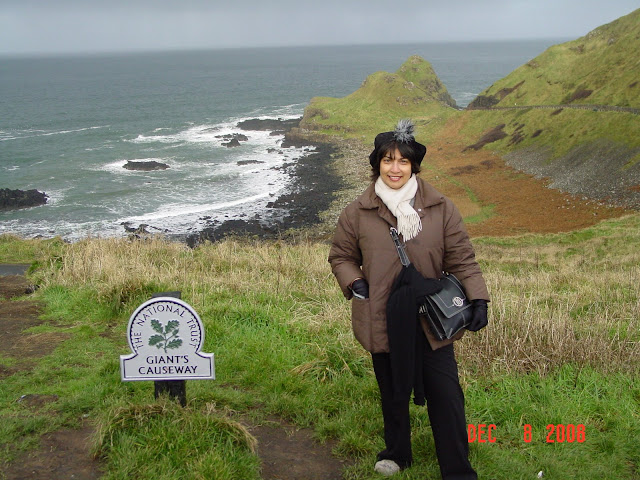At the cliffs leading down to the Giant’s Causeway
I arrived alone in Northern Ireland in December 2008, at a time that was very cold and very bleak. I had been spending a year in London and did not want to return to the USA without visiting Northern Ireland, a place I knew only through its political and religious notoriety. I was curious to see for myself the extent to which decades, if not centuries, of strife had burned themselves into the country and its culture and into the temperament of the people.
Would they, for instance, be as warm, friendly and hospitable as their southern counterparts? Did they share that passion for music and humor and bars and bon homie that their neighbors knew so well? How had their squabbles affected the landscape and the mood, both in the cities and in the countryside?
This was what I intended to discover first-hand in the few days I spent as I traveled from Belfast, along the Causeway Coast towards the Giant’s Causeway and the Glens and Forests of Antrim and finally in Londonderry. The trip was an eye-opener for me and a way to enlighten myself about a region of the world that captured the public imagination and hogged media attention for years.
I found Nothern Ireland very different from the Southern portion. There was none of the gaiety of spirit that is everywhere in the South. Though I clearly was in Ireland, the Englishness of the space is very evident. There is an indefinable spirit in the region that is common to say, London or Edinburgh but not Dublin or Galway. I don’t know if I imagined this, but I found a rather dour pervasiveness about the areas I visited.
Of course, Northern Ireland is as beautiful as its southern counterpart. In fact, the line of demarcation eludes the countryside where emerald fields merge seamlessly from south to north in a pattern that is repetitive but pleasing in its simplicity and charm–flocks of placid sheep, white washed farm houses, hedges separating land holdings, towering cliffs that cling tenaciously to foamy shores lapped by ferocious waves and rocky coves and bays often prettifed by rustic craft that bob in rural waters. I enjoyed this element of Northern Ireland a great deal.
It was the cities that troubled me for they still harbor ghosts of the country’s troubled past. Evidence of brutal loss, ancient and more recent, is emblazoned upon the walls in larger-than-life sized murals that speak of the pain and suffering of a people who still consider their voices suppressed. In Derry, for instance and in Belfast, parts of the city are separated in tangible terms by walls that might call themselves ‘Peace Walls’ today but were once raised to separate Protestant from Catholic, Loyalist from Rebel. The mood of gloom is definitely in evidence here as is the defaince in the tone of the guides who give tours and espouse their brand of radical ideology. It is disturbing even today when a tenuous peace agreement is in place. It was this Northern Ireland that I found problematic. It was this atmosphere from which I found it hard to escape though I sought comfort in historic bars and retail therapy in designer stores.
Northern Ireland is trying hard to resurrect itself from the years of strife that embattled it. Though travelers are returning today and the government is attempting to heal raw wounds, I do believe that it will be a while before all vestiges of age-old rancour can be completely wiped out.
Bon Voyage!
